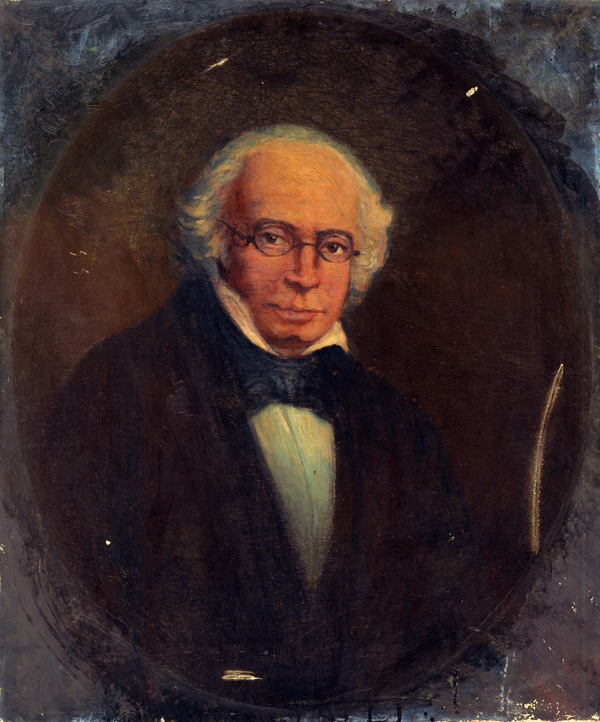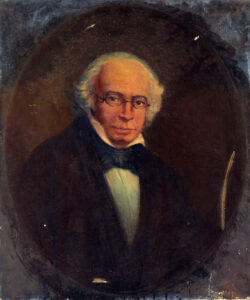West Florida Revolt
The Florida Parishes were not included in the Louisiana Purchase but were under Spanish control.

Courtesy of Louisiana State Museum.
This portrait of Don Carlos de Hault de Lassus, governor of Spanish West Florida, was made ca. 1916.
Among the most common misconceptions about Louisiana is the belief that the entire modern state was included in the 1803 Louisiana Purchase. Popular representations of the state—and even many scholarly publications—fail to note that the Florida Parishes were not included in either the purchase or the state of Louisiana as originally constituted. Located in the southeastern part of the state, the Florida Parishes included present-day East Baton Rouge, East Feliciana, Livingston, St. Helena, St. Tammany, Tangipahoa, Washington, and West Feliciana Parishes. Not until an armed insurrection against the existing government, known as the West Florida Revolt, took place in 1810 were the geographic boundaries that appear on a map today created.
The Florida Parishes and The Louisiana Purchase
Louisiana’s Florida parishes, the region constituting the “toe” of the state between the Mississippi and Pearl Rivers, north of Lake Pontchartrain, display one of the most peculiar patterns of development found anywhere in the nation. Alternately controlled by France, Britain, and Spain, the territorial ambiguity that characterized the region made it a haven for British loyalists avoiding persecution at the hands of American revolutionaries, along with army deserters and various types of desperadoes who thrived in the absence of firm government control. Even worse, each governing power awarded its own generous land claims, adding to the prevailing territorial confusion.
Despite such reasons for concern, when President Thomas Jefferson dispatched emissaries to secure purchase of the Louisiana Territory from France, they were instructed to secure the region known as West Florida; this would complete American control of the east bank of the Mississippi River. Although Jefferson’s emissaries secured far more territory in the purchase than they could have imagined, West Florida was notably absent from their acquisition. American officials would later seek to justify subsequent actions by arguing that West Florida was indeed included in the purchase. But the fact remains that in 1803 when the Louisiana Purchase was consummated, West Florida remained under the authority of Spain, rendering the region ripe for revolt.
The Struggle Begins
When the details of the Louisiana Purchase became known, considerable disappointment at the exclusion of West Florida was evident among the pro-American faction in the territory. Such sentiment was particularly evident in the wealthy Feliciana District near the border of the Mississippi Territory. Others, including British loyalists, who were hostile to the new American republic, as well as those who resided on significant Spanish land grants that American control might have threatened, remained loyal to Spain. Spanish control appealed to still others in the area, who enjoyed the absence of taxation and laissez faire attitude toward governance practiced by the Spanish. Accordingly when, in 1804, a group of insurrectionists from the neighboring Mississippi Territory, led by Ruben Kemper and his brothers, crossed into West Florida seeking to wrest control of the region by attacking the Spanish fort at Baton Rouge, many residents rallied to support the Spanish in repelling the invasion.
In the aftermath of the failed Kemper Rebellion of 1804, three distinct factions emerged in the territory. The pro-American faction favored independence from Spain and annexation by the United States. The second, and perhaps largest, group remained nominally loyal to Spain, largely owing to government patronage, fear of prosecution in American courts, or to protect their land holdings. The third faction may best be known as the independents. This group favored the creation of a new republic under their own authority. Although the personal writings of members of this group suggest that they understood their little republic could not maintain itself for long amid the greedy world powers that remained in the area, they nonetheless proved a powerful voice for the creation of the republic.
The Rebellion Gains Momentum
Events emanating from Europe provided the catalyst for rebellion. French intrigues in Spain appeared to compromise Spanish authority at almost the same time the popular governor of West Florida, Don Carlos de Grand-Pre, was replaced by the bland and vacillating Carlos de Hault de Lassus. Though well intentioned, de Lassus became a belated player in a complex cycle of high-stakes intrigue. With his position weakened by growing French hegemony over the Spanish crown, de Lassus sought to strike a conciliatory tone with the increasingly assertive pro-independence factions. On June 23, 1810, a large group of Feliciana residents gathered at Egypt Plantation and called for the establishment of a convention, ostensibly to “secure themselves against foreign invasion and domestic disturbance.” Four men were selected as delegates—with authority to solicit representatives from the neighboring districts of Baton Rouge, St. Helena, and Chifoncte—to attend a convention scheduled for July 25, 1810, at St. Johns Plains.
When the convention met, John Rhea of Feliciana was selected as chairman. Fearful of provoking the wrath of Spain, the assembled delegates avoided discussion of rebellion and instead drafted a resolution declaring their intention to assist de Lassus in governing the territory, due to his weakened capacity as a result of events transpiring in Europe. Although the resolution was clearly a veiled usurpation of authority, with only twenty-eight troops at his disposal, de Lassus feigned acceptance of the resolution. During the next few weeks he hosted a series of “peace dinners,” replete with the firing of salutes by the artillery in the fort, where he wined and dined the convention delegates. Spanish officers in the fort were outraged by his temerity, even more so when pro-independence broadsides began appearing along country roads. Unmoved by the frustration of his troops, the harried governor continued to vacillate.
Other Spanish loyalists proved more decisive. The delegate from the Chifoncte district, William Cooper, secretly wrote the Spanish governor, Vincente Folch, at Pensacola. In the letter Cooper explained that the convention was actually a front to foment rebellion engineered by a minority of planters in the Feliciana district. Cooper urged Folch to personally lead a force of troops to the district and restore the authority of the Spanish crown. He further advised that he, along with prominent planter Michael Jones and others, was rallying troops and constructing fortifications to support Folch when he arrived.
Amid the increasingly obvious guile and intrigue surrounding him, de Lassus finally determined to act lest he be accused of complicity in sedition. He counted among his friends Shepard Brown, alcalde of the St. Helena district, who had earlier promised the governor he could raise five hundred men to support the Spanish cause if needed. Isolated and desperate, de Lassus penned a message to Brown calling for aid from loyal inhabitants. A second message was to be forwarded to Governor Folch, requesting him to rush troops to de Lassus’ assistance. Unfortunately for de Lassus, the messenger was intercepted by a party of men loyal to the convention, who detained the rider and delivered his messages to the convention.
The Rebels Declare Independence
Convinced of the governor’s duplicity, the convention delegates gathered at Troy Plantation near St. Francisville and acknowledged that they were now in danger of arrest for treason and must act decisively. They selected Philemon Thomas to lead a force of volunteers to storm the fort at Baton Rouge in preparation for a declaration of independence. All through the day of September 22, 1810, Thomas dispatched riders to the outlying districts calling for men to concentrate on the outskirts of Baton Rouge that night. Columns of men from Feliciana, St. Helena, and Springfield all advanced toward Baton Rouge. Shortly before midnight the “Bayou Sara Horse” arrived, to be joined moments later by the column from Springfield. The men anxiously awaited the arrival of the troops from St. Helena.
As the rebels concentrated just outside the town, the Spanish in Baton Rouge were aware that something was up. During the course of the day, de Lassus received at least two warnings, one from a Spanish loyalist in St. Francisville advising that the neighboring village of Bayou Sara was armed and hostile. Yet, other than doubling the guard at the fort, de Lassus made no effort to disrupt the actions of the rebels. Even though the earthen fort was in need of repair, the governor seemed confident that it would prove a tough obstacle to rebels lacking artillery.
Thomas likewise feared that his men would meet a harsh response from the artillery in the fort if he tried a frontal assault, especially if he waited until daylight. Advised of a gap in the fort wall that allowed access to the garrison’s dairy cattle, Thomas ordered some of his men to enter the fort under the cover of darkness and early morning fog. In a short firefight, the rebels quickly overpowered the Spanish and raised the convention flag over the fort. The West Florida Convention immediately endorsed the actions of the rebels and ordered Thomas to advance at the head of an army of four hundred men to secure the remainder of the region for the new republic. Spanish loyalists, including Shepard Brown and Michael Jones, submitted to the power of the rebel force, ordered the men they had collected to disperse, and pledged loyalty to the new republic. William Cooper collected another force to oppose the rebels near Springfield, but hearing the size of the approaching “army,” they too dispersed only hours before the force arrived. The rebels later captured and killed Cooper, an act that provoked deep resentment in the Tchefuncte and Tangipahoa River regions.
A separate force led by Ruben Kemper was dispatched to capture Mobile, Alabama, but before they could complete their mission, the inevitable American response occurred. President James Madison ordered William C. C. Claiborne to enter the territory and claim it for the United States. Though many of the rebels sought such annexation as the best outcome for the new republic, many disliked the American methods. Claiborne entered the territory with significant ground troops and a naval flotilla. Together they provided overwhelming force, and on December 10, 1810, the rebels reluctantly lowered the Lone Star flag of the Republic of West Florida, bringing the seventy-four-day-old nation to a close. Though some lingering resentment concerning land claims and the status of army deserters remained, especially in the Tchefuncte River area, no further popular risings resulted.
The West Florida Revolt and resulting republic may have lasted only seventy-four days, but it left an indelible mark on the region. The Florida Parishes, as the old republic is now known, derive much of their distinctive identity from the peculiar pattern of development most overtly manifested in the West Florida Revolt.
